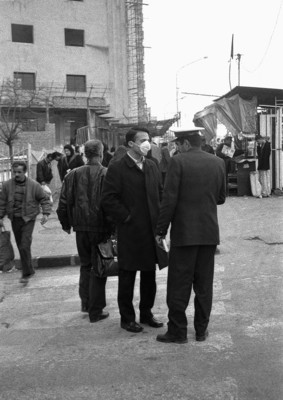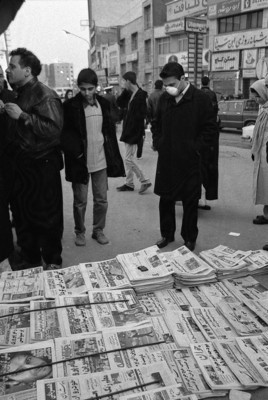You can hear their voices. Their steps are heavy and they are breathless. Among the massive crowd of the streets and public passages, they put on their masks one by one to begin the new act in their city play.
“Excuse me sir… Madam, would you please… a few moments… I, … I, … have left my wallet, could I ask you… ToopKhooneh street, Bazaar, two more passengers, ToopKhooneh…1”
Having dropped the masks, retired from the permanent play of time, they are sunken into deep negligence at the steering wheels of their cars or in the backseats of taxis so that they wouldn’t wait for another tomorrow, wouldn’t wait for anything else except the masks that the city would put on their faces. A new game is coming, an earthquake to arouse the national resolution or a religious occasion so that everyone can prove that they are religious or that they are not and…
We established the artist-group Arta in early 2003. There were four of us then, working in the fields of theater and cinema. We did not intend to work within a particular art form; rather we wanted to achieve multifaceted works based on our own capabilities as well as other artists’ cooperation. We have based our work on experience and research, and in most of our sessions we sketch out our projects through discussion and exchange of experiences.
In October 2003 we started a project on Tehran. The idea of the project had initially originated from working with some young theater and cinema students. They worked with me for a year. It was in fact a kind of training. They wanted to experiment outside the professional space of Iranian theater. After a long search, having failed to find a suitable place for our rehearsals, we decided to use the city space i.e., parks, streets, even the mountains around the city. This led us, most of the time, to sketch up rehearsals with urban subject matter that dealt directly with people. Interestingly, sometimes in rehearsals that did not directly relate to people, they unconsciously (and sometimes consciously) entered the play.
When we decided to begin the Tehran project, we found it a good idea to include the experiences of those students in this project. Thus the young group joined Arta. Again, we went to the city space, this time with the presumption that the city space was tantamount to a theater stage and that people with their urban presence and behavior were the actors on the stage. The interesting point at the beginning was the defensive position taken by the group against the city. The members who (all but two of them) were born and had grown up in Tehran, were alien to their city and had guarded against it. That was perhaps a reflection of the contradiction that existed between their private lives and the public life in the city, a contradiction they had never encountered consciously, although they were living in its midst. Our initial works were attempts to break that guard and to directly engage the group in the realities of the city.
The open and current urban space of Tehran is a labyrinthine experience. Tehran has a contradictory urban structure. The traditional texture of the city still exists in some of its southern parts and some northern parts have maintained their initial rural appearance. But the city is rapidly changing to a metropolitan city that is a composition of physical, social and political heterogeneity.
The young population, the contradiction between the private and the public life of the citizens, the heterogeneous architecture and the constant change of the public spaces into stages for demonstrations and different religious and traditional ceremonies are what outline the indefinite identity of the city.
But as things go, Tehran could find a new identity in which life would be like a game, a game with no winning or losing. To be consciously engaged in this unconscious game would change the citizens of this city to actors. We register the dramatic behavior in the city, enter the actual conditions of this behavior, seek our roles there and recreate our findings in our plays.
And we are trying to find out this significant point: If the public space of the city has the function of a theater stage, then where is its backstage?
- ∗ Toopkhouneh (colloquial of Toopkhaneh) is the name of a famous square downtownTehran, near the Bazaar. A taxi driver is crying out for two more passengers for those destinations. (Most of the taxis here won’t steer for the destination before they have picked up five passengers!)↩

